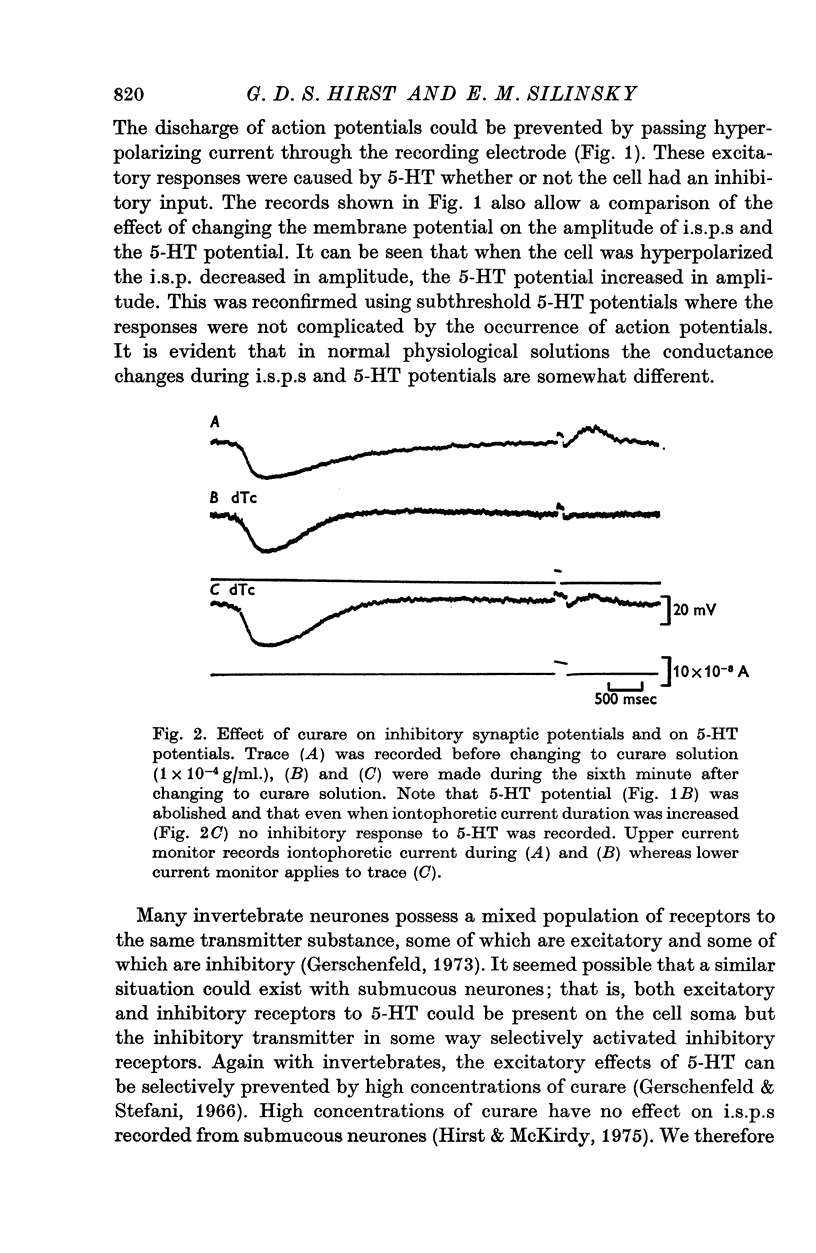Abstract
1. Responses to the iontophoretic application of 5-hydroxytryptamine (5-HT), dopamine and noradrenaline were examined in neurones of the submucous plexus of guinea-pig small intestine. 2. Every neurone was excited by 5-HT. 3. In a proportion of cells, dopamine or noradrenaline caused an increase in membrane potential. This response was only observed in cells which received in inhibitory innervation. The responses closely resembled inhibitory synaptic potentials evoked by transmural stimulation. 4. Both inhibitory synaptic potentials and inhibitory responses to dopamine and noradrenaline were blocked by methysergide. 5. It seems possible that these two catecholamines may interact with similar receptors to those activated by inhibitory transmitter.
Full text
PDF















Selected References
These references are in PubMed. This may not be the complete list of references from this article.
- AXELSSON J., THESLEFF S. A study of supersensitivity in denervated mammalian skeletal muscle. J Physiol. 1959 Jun 23;147(1):178–193. doi: 10.1113/jphysiol.1959.sp006233. [DOI] [PMC free article] [PubMed] [Google Scholar]
- Ambache N., Dunk L. P., Verney J., Zar M. A. An inhibition of post-ganglionic motor transmission in the mammalian vas deferens by D-lysergic acid diethylamide. J Physiol. 1973 Jun;231(2):251–270. doi: 10.1113/jphysiol.1973.sp010231. [DOI] [PMC free article] [PubMed] [Google Scholar]
- Ascher P. Inhibitory and excitatory effects of dopamine on Aplysia neurones. J Physiol. 1972 Aug;225(1):173–209. doi: 10.1113/jphysiol.1972.sp009933. [DOI] [PMC free article] [PubMed] [Google Scholar]
- BLACKMAN J. G., GINSBORG B. L., RAY C. Synaptic transmission in the sympathetic ganglion of the frog. J Physiol. 1963 Jul;167:355–373. doi: 10.1113/jphysiol.1963.sp007155. [DOI] [PMC free article] [PubMed] [Google Scholar]
- Bland K. P., House C. R., Ginsborg B. L., Laszlo I. Catecholamine transmitter for salivary secretion in the cockroach. Nat New Biol. 1973 Jul 4;244(131):26–27. doi: 10.1038/newbio244026a0. [DOI] [PubMed] [Google Scholar]
- DEL CASTILLO J., KATZ B. On the localization of acetylcholine receptors. J Physiol. 1955 Apr 28;128(1):157–181. doi: 10.1113/jphysiol.1955.sp005297. [DOI] [PMC free article] [PubMed] [Google Scholar]
- Dennis M. J., Harris A. J., Kuffler S. W. Synaptic transmission and its duplication by focally applied acetylcholine in parasympathetic neurons in the heart of the frog. Proc R Soc Lond B Biol Sci. 1971 Apr 27;177(1049):509–539. doi: 10.1098/rspb.1971.0045. [DOI] [PubMed] [Google Scholar]
- Dun N., Nishi S. Effects of dopamine on the superior cervical ganglion of the rabbit. J Physiol. 1974 May;239(1):155–164. doi: 10.1113/jphysiol.1974.sp010560. [DOI] [PMC free article] [PubMed] [Google Scholar]
- GYERMEK L. 5-hydroxytryptamine antagonists. Pharmacol Rev. 1961 Sep;13:399–439. [PubMed] [Google Scholar]
- Gerschenfeld H. M. Chemical transmission in invertebrate central nervous systems and neuromuscular junctions. Physiol Rev. 1973 Jan;53(1):1–119. doi: 10.1152/physrev.1973.53.1.1. [DOI] [PubMed] [Google Scholar]
- Gerschenfeld H. M., Stefani E. An electrophysiological study of 5-hydroxytryptamine receptors of neurones in the molluscan nervous system. J Physiol. 1966 Aug;185(3):684–700. doi: 10.1113/jphysiol.1966.sp008010. [DOI] [PMC free article] [PubMed] [Google Scholar]
- Ginsborg B. L., House C. R., Silinsky E. M. Conductance changes associated with the secretory potential in the cockroach salivary gland. J Physiol. 1974 Feb;236(3):723–731. doi: 10.1113/jphysiol.1974.sp010462. [DOI] [PMC free article] [PubMed] [Google Scholar]
- Ginsborg B. L. Ion movements in junctional transmission. Pharmacol Rev. 1967 Sep;19(3):289–316. [PubMed] [Google Scholar]
- Hirst G. D., McKirdy H. C. Presynaptic inhibition at mammalian peripheral synapse? Nature. 1974 Aug 2;250(465):430–431. doi: 10.1038/250430a0. [DOI] [PubMed] [Google Scholar]
- Hirst G. D., McKirdy H. C. Synaptic potentials recorded from neurones of the submucous plexus of guinea-pig small intestine. J Physiol. 1975 Jul;249(2):369–385. doi: 10.1113/jphysiol.1975.sp011020. [DOI] [PMC free article] [PubMed] [Google Scholar]
- House C. R., Ginsborg B. L., Silinsky E. M. Dopamine receptors in cockroach salivary gland cells. Nat New Biol. 1973 Sep 12;245(141):63–63. doi: 10.1038/newbio245063a0. [DOI] [PubMed] [Google Scholar]
- Nishi S., North R. A. Intracellular recording from the myenteric plexus of the guinea-pig ileum. J Physiol. 1973 Jun;231(3):471–491. doi: 10.1113/jphysiol.1973.sp010244. [DOI] [PMC free article] [PubMed] [Google Scholar]
- Purves R. D. Muscarinic excitation: a microelectrophoretic study on cultured smooth muscle cells. Br J Pharmacol. 1974 Sep;52(1):77–86. doi: 10.1111/j.1476-5381.1974.tb09689.x. [DOI] [PMC free article] [PubMed] [Google Scholar]
- Werman R., Wislicki L. Propranolol, a curariform and cholinomimetic agent at the frog neuromuscular junction. Comp Gen Pharmacol. 1971 Mar;2(5):69–81. doi: 10.1016/0010-4035(71)90070-x. [DOI] [PubMed] [Google Scholar]
- Woodruff G. N. Dopamine receptors: a review. Comp Gen Pharmacol. 1971 Dec;2(8):439–455. doi: 10.1016/0010-4035(71)90041-3. [DOI] [PubMed] [Google Scholar]


